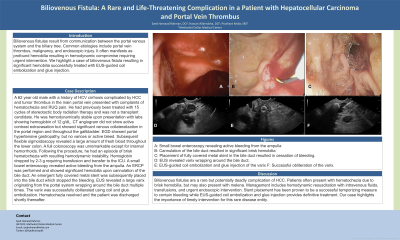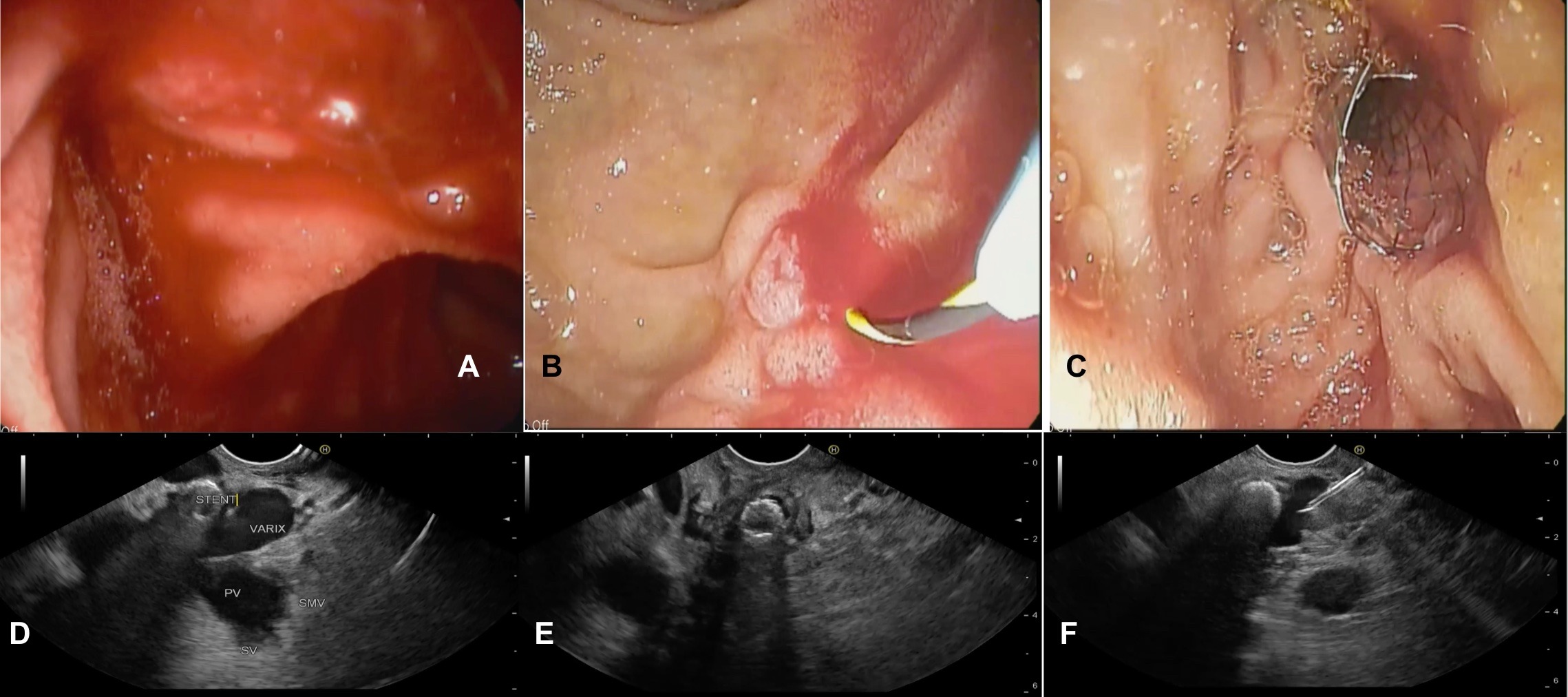Monday Poster Session
Category: Biliary/Pancreas
P1522 - Biliovenous Fistula: A Rare and Life-Threatening Complication in a Patient with Hepatocellular Carcinoma and Portal Vein Thrombus
Monday, October 23, 2023
10:30 AM - 4:15 PM PT
Location: Exhibit Hall

Has Audio

Syed Hamaad Rahman, DO
Methodist Dallas Medical Center
Dallas, TX
Presenting Author(s)
Syed Hamaad Rahman, DO, Hassan Allahrakha, DO, Prashant S. Kedia, MD
Methodist Dallas Medical Center, Dallas, TX
Introduction: Biliovenous fistulas result from communication between the portal venous system and the biliary tree. Common etiologies include portal vein thrombus, malignancy, and endoscopic injury. It often manifests as profound hemobilia resulting in hemodynamic compromise requiring urgent intervention. We highlight a case of biliovenous fistula resulting in significant hemobilia successfully treated with EUS-guided coil embolization and glue injection.
Case Description/Methods: A 62 year old male with a history of HCV cirrhosis complicated by HCC and tumor thrombus in the main portal vein presented with complaints of hematochezia and RUQ pain. He had previously been treated with 15 cycles of stereotactic body radiation therapy and was not a transplant candidate. He was hemodynamically stable upon presentation with labs showing hemoglobin of 12 g/dL. CT angiogram did not show active contrast extravasation but showed significant venous collateralization in the portal region and throughout the gallbladder. EGD showed portal hypertensive gastropathy, but no varices or active bleed. Subsequent flexible sigmoidoscopy revealed a large amount of fresh blood throughout the lower colon. A full colonoscopy was unremarkable except for internal hemorrhoids. Following the procedure, he had an episode of brisk hematochezia with resulting hemodynamic instability. Hemoglobin dropped by 2-3 g requiring transfusion and transfer to the ICU. A small bowel enteroscopy revealed active bleeding from the ampulla. An ERCP was performed and showed significant hemobilia upon cannulation of the bile duct. An emergent fully covered metal stent was subsequently placed into the bile duct which stopped the bleeding. EUS revealed a large varix originating from the portal system wrapping around the bile duct multiple times. The varix was successfully obliterated using coil and glue embolization. Hematochezia resolved and the patient was discharged shortly thereafter.
Discussion: Biliovenous fistulas are a rare but potentially deadly complication of HCC. Patients often present with hematochezia due to brisk hemobilia, but may also present with melena. Management includes hemodynamic resuscitation with intravenous fluids, transfusions, and urgent endoscopic intervention. Stent placement has been proven to be a successful temporizing measure to contain bleeding while EUS-guided coil embolization and glue injection provides definitive treatment. Our case highlights the importance of timely intervention for this rare disease entity.

Disclosures:
Syed Hamaad Rahman, DO, Hassan Allahrakha, DO, Prashant S. Kedia, MD. P1522 - Biliovenous Fistula: A Rare and Life-Threatening Complication in a Patient with Hepatocellular Carcinoma and Portal Vein Thrombus, ACG 2023 Annual Scientific Meeting Abstracts. Vancouver, BC, Canada: American College of Gastroenterology.
Methodist Dallas Medical Center, Dallas, TX
Introduction: Biliovenous fistulas result from communication between the portal venous system and the biliary tree. Common etiologies include portal vein thrombus, malignancy, and endoscopic injury. It often manifests as profound hemobilia resulting in hemodynamic compromise requiring urgent intervention. We highlight a case of biliovenous fistula resulting in significant hemobilia successfully treated with EUS-guided coil embolization and glue injection.
Case Description/Methods: A 62 year old male with a history of HCV cirrhosis complicated by HCC and tumor thrombus in the main portal vein presented with complaints of hematochezia and RUQ pain. He had previously been treated with 15 cycles of stereotactic body radiation therapy and was not a transplant candidate. He was hemodynamically stable upon presentation with labs showing hemoglobin of 12 g/dL. CT angiogram did not show active contrast extravasation but showed significant venous collateralization in the portal region and throughout the gallbladder. EGD showed portal hypertensive gastropathy, but no varices or active bleed. Subsequent flexible sigmoidoscopy revealed a large amount of fresh blood throughout the lower colon. A full colonoscopy was unremarkable except for internal hemorrhoids. Following the procedure, he had an episode of brisk hematochezia with resulting hemodynamic instability. Hemoglobin dropped by 2-3 g requiring transfusion and transfer to the ICU. A small bowel enteroscopy revealed active bleeding from the ampulla. An ERCP was performed and showed significant hemobilia upon cannulation of the bile duct. An emergent fully covered metal stent was subsequently placed into the bile duct which stopped the bleeding. EUS revealed a large varix originating from the portal system wrapping around the bile duct multiple times. The varix was successfully obliterated using coil and glue embolization. Hematochezia resolved and the patient was discharged shortly thereafter.
Discussion: Biliovenous fistulas are a rare but potentially deadly complication of HCC. Patients often present with hematochezia due to brisk hemobilia, but may also present with melena. Management includes hemodynamic resuscitation with intravenous fluids, transfusions, and urgent endoscopic intervention. Stent placement has been proven to be a successful temporizing measure to contain bleeding while EUS-guided coil embolization and glue injection provides definitive treatment. Our case highlights the importance of timely intervention for this rare disease entity.

Figure: A: Small bowel enteroscopy revealing active bleeding from the ampulla
B: Cannulation of the bile duct resulted in significant brisk hemobilia
C: Placement of fully covered metal stent in the bile duct resulted in cessation of bleeding.
D: EUS revealed varix wrapping around the bile duct.
E: EUS-guided coil embolization and glue injection of the varix
F: Successful obliteration of the varix.
B: Cannulation of the bile duct resulted in significant brisk hemobilia
C: Placement of fully covered metal stent in the bile duct resulted in cessation of bleeding.
D: EUS revealed varix wrapping around the bile duct.
E: EUS-guided coil embolization and glue injection of the varix
F: Successful obliteration of the varix.
Disclosures:
Syed Hamaad Rahman indicated no relevant financial relationships.
Hassan Allahrakha indicated no relevant financial relationships.
Prashant Kedia: Boston Scientific – Consultant. Medtronic – Consultant. Olympus – Consultant.
Syed Hamaad Rahman, DO, Hassan Allahrakha, DO, Prashant S. Kedia, MD. P1522 - Biliovenous Fistula: A Rare and Life-Threatening Complication in a Patient with Hepatocellular Carcinoma and Portal Vein Thrombus, ACG 2023 Annual Scientific Meeting Abstracts. Vancouver, BC, Canada: American College of Gastroenterology.
